

Forensic photography. Footwear impressions left at a crime scene.
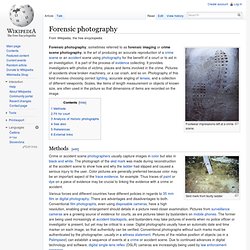
Methods[edit] Skid mark from faulty ladder Crime or accident scene photographers usually capture images in color but also in black and white. The photograph of the skid mark was made during reconstruction at the accident scene to show how and why the ladder had slipped and caused a serious injury to the user.
Color pictures are generally preferred because color may be an important aspect of the trace evidence, for example. Various forces and different countries have different policies in regards to 35 mm film or digital photography. Fit for court[edit] The images must be clear and usually have scales. Road traffic incident (RTI) photographs show the overall layout at the scene taken from many different angles, with close-ups of significant damage, or trace evidence such as tire marks at a traffic collision.
As with all evidence a chain of custody must be maintained for crime scene photographs. Analysis of historic photographs[edit] See also[edit] Photomicrography Competition. Scientific photography - Photography - Library Subject Guides at RMIT University. Compound Eye: the many facets of science photography. A compound eye is a visual sensory organ composed of numerous small lenses.
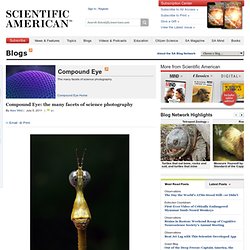
This charming South American grasshopper sports an especially large pair. Welcome to Compound Eye, a Scientific American photography blog! The blog is new, but the blogger is not. My name is Alex Wild. I am an entomologist and nature photographer based in Champaign-Urbana, Illinois, and I have been writing about insects, science, and photography at Myrmecos Blog since 2007. While Myrmecos will continue at its present location with more or less the same content, Compound Eye is a new venture featuring: Spectacular photographs from across the sciences, accompanied by interviews with the people behind the images.How-To articles on photographic technique.
This being a photography blog, a photo essay should serve as an appropriate introduction to my work: Collecting ants in Amazonian Ecuador, January 2011. Leafcutter ants (Atta species) are among the more spectacular insects of the American tropics. Dennis Kunkel Microscopy, Inc. Microscopy and Science Education Web Site. Special Report - International Science and Engineering Visualization Challenge. Thank you for your interest in the International Science & Engineering Visualization Challenge.

We are in the process of restructuring the Visualization Challenge. We will begin accepting entries in September 2014. Please visit this site periodically for updates. Some of science's most powerful statements are not made in words. From DaVinci's Vitruvian Man to Rosalind Franklin's X-rays, science visualization has a long and literally illustrious history. The National Science Foundation (NSF) and the journal Science created the International Science & Engineering Visualization Challenge to celebrate the grand tradition of science visualization and to encourage its continued growth. Judges appointed by NSF and Science will select winners in five categories: Photography, Illustration, Posters & Graphics, Games & Apps, and Video. View the video below highlighting past winners of the International Science & Engineering Visualization Challenge.
View Forum - Technical and scientific photography. Medical and Scientific Photography Home Page. Pioneers of Invisible Radiation Photography - Contents. Infrared Photography - Contents. Reflected Ultraviolet Photography - Contents. Fluorescence Photography - Contents. Concursul de Fotografie Stiintifica de MILSET - Pagina iniţială. Esti interesat de tot ceea ce te înconjoara?
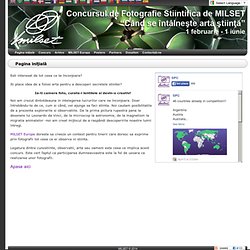
Iti place idea de a folosi arta pentru a descoperi secretele stiintei? Ia-ti camera foto, curate-i lentilele si devin-o creativ! Noi am crezut dintotdeauna in intelegerea lucrurilor care ne înconjoara. Doar întrebându-te de ce, cum si când, vei ajunge sa faci stiinta. Noi cautam posibilitatile de a prezenta explorarile si observatiile.
MILSET Europe doreste sa creeze un context pentru tinerii care doresc sa exprime prin fotografii tot ceea ce ei observa in stiinta. Legatura dintre cunostiinte, observatii, arta sau oameni este ceea ce implica acest concurs. Apasa aici Translated by. Science Photo Library. Scientific Photography. Scientific photography is about visualizing things that can't be seen with the unaided eye.
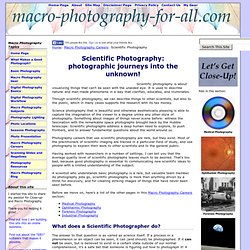
It is used to describe natural and man-made phenomena in a way that clarifies, educates, and illuminates. Through scientific photography, we can describe things to other scientists, but also to the public, which in many cases supports the research with its tax money. Science photography that is beautiful and otherwise aesthetically pleasing is able to capture the imagination of the viewer to a degree unlike any other style of photography.
Something about images of things never scene before: witness the fascination with the remarkable space photographs brought back by the Hubble telescope. Scientific photographs address a deep human need to explore, to push frontiers, and to answer fundamental questions about the world around us. Photography careers that use scientific photography are rare, but they exist. A scientist who understands basic photography is a rare, but valuable team member. Lighting. Science Photography Spotlight. On January 7, 1839, an installation artist and chemist named Louis-Jacques-Mandé Daguerre announced to the French Academy of Sciences in Paris that he had perfected a photographic imaging technology that could be used on a large scale and was reproducible.
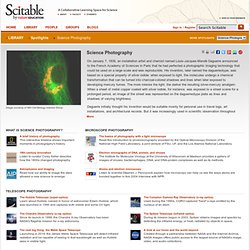
His invention, later named the daguerreotype, was based on a special property of silver iodide: when exposed to light, the molecules undergo a chemical transformation that can be turned into charcoal-colored shadows and lines when later exposed to developing mercury fumes. The more intense the light, the darker the resulting silver-mercury amalgam. When a sheet of metal copper coated with silver iodide, for instance, was exposed to a street scene for a prolonged period, an image of the street was represented on the daguerreotype plate as lines and shadows of varying brightness. Daguerre initially thought his invention would be suitable mostly for personal use in travel logs, art installations, and architectural records.